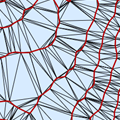|
CGAL 5.4 - 2D Triangulations
|
|
CGAL 5.4 - 2D Triangulations
|

A triangulation is a 2-dimensional simplicial complex which is pure connected and without singularities. Thus a triangulation can be viewed as a collection of triangular faces, such that two faces either have an empty intersection or share an edge or a vertex.
The basic elements of the representation are vertices and faces. Each triangular face gives access to its three incident vertices and to its three adjacent faces. Each vertex gives access to one of its incident faces and through that face to the circular list of its incident faces. The edges are not explicitly represented, they are only represented through the adjacency relations of two faces.
The triangulation classes of CGAL depend on two template parameters. The first template parameter stands for a geometric traits class which is assumed to provide the geometric objects (points, segments and triangles) forming the triangulation and the geometric predicates on those objects. The second template parameter stands for a model of triangulation data structure acting as a container for faces and vertices while taking care of the combinatorial aspects of the triangulation. The concepts and models relative to the triangulation data structure are described in Chapter 2D Triangulation Data Structure.
TriangulationTraits_2DelaunayTriangulationTraits_2RegularTriangulationTraits_2ConstrainedTriangulationTraits_2ConstrainedDelaunayTriangulationTraits_2TriangulationFaceBase_2TriangulationVertexBase_2ConstrainedTriangulationFaceBase_2RegularTriangulationFaceBase_2RegularTriangulationVertexBase_2TriangulationHierarchyVertexBase_2TriangulationVertexBaseWithInfo_2CGAL::Triangulation_2<Traits,Tds>CGAL::Delaunay_triangulation_2<Traits,Tds>CGAL::Regular_triangulation_2<Traits,Tds>CGAL::Constrained_triangulation_2<Traits,Tds,Itag>CGAL::Constrained_Delaunay_triangulation_2<Traits,Tds,Itag>CGAL::Constrained_triangulation_plus_2<Tr>CGAL::Triangulation_hierarchy_2<Tr>CGAL::Triangulation_face_base_2<Traits,Fb>CGAL::Triangulation_vertex_base_2<Traits,Vb>CGAL::Regular_triangulation_face_base_2<Traits,Fb>CGAL::Regular_triangulation_vertex_base_2<Traits,Vb>CGAL::Constrained_triangulation_face_base_2<Traits,Fb>CGAL::Triangulation_vertex_base_with_info_2<Info,Traits,Vb>CGAL::Triangulation_face_base_with_info_2<Info,Traits,Fb>CGAL::Triangulation_hierarchy_vertex_base_2<Vb>CGAL::Triangulation_cw_ccw_2Modules | |
| Concepts | |
| Triangulation Classes | |
| Vertex and Face Classes | |
| Miscellaneous | |
| Draw a Triangulation 2 | |